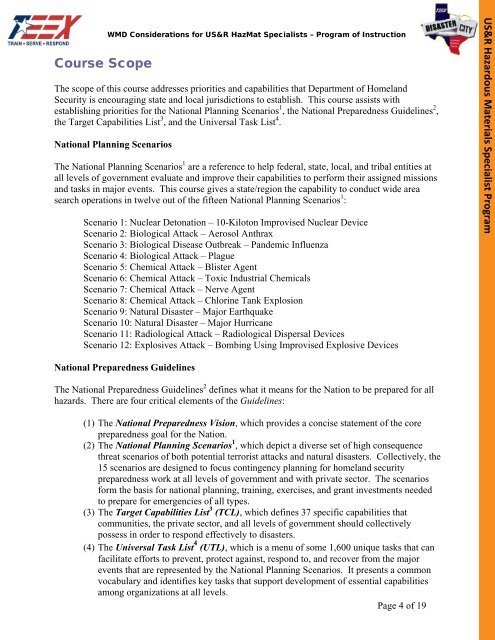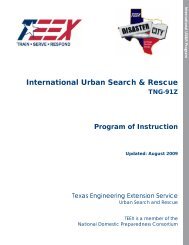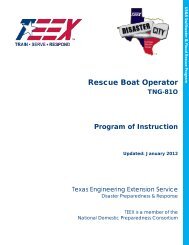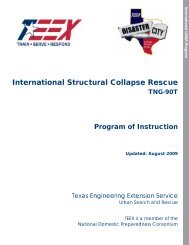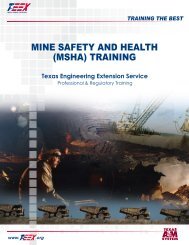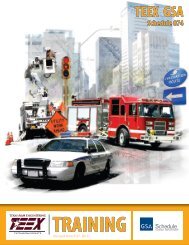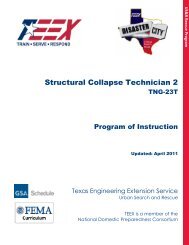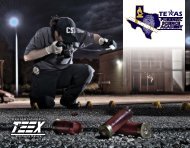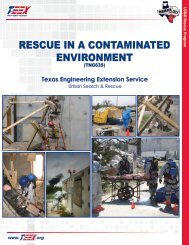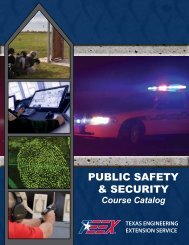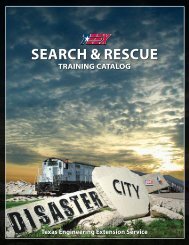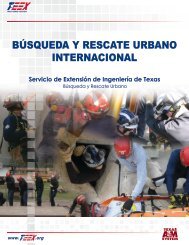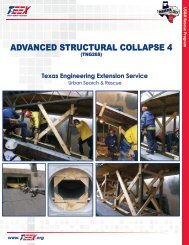WMD Considerations for US&R Hazardous Materials Specialists
WMD Considerations for US&R Hazardous Materials Specialists
WMD Considerations for US&R Hazardous Materials Specialists
You also want an ePaper? Increase the reach of your titles
YUMPU automatically turns print PDFs into web optimized ePapers that Google loves.
Course Scope<br />
<strong>WMD</strong> <strong>Considerations</strong> <strong>for</strong> US&R HazMat <strong>Specialists</strong> – Program of Instruction<br />
The scope of this course addresses priorities and capabilities that Department of Homeland<br />
Security is encouraging state and local jurisdictions to establish. This course assists with<br />
establishing priorities <strong>for</strong> the National Planning Scenarios 1 , the National Preparedness Guidelines 2 ,<br />
the Target Capabilities List 3 , and the Universal Task List 4 .<br />
National Planning Scenarios<br />
The National Planning Scenarios 1 are a reference to help federal, state, local, and tribal entities at<br />
all levels of government evaluate and improve their capabilities to per<strong>for</strong>m their assigned missions<br />
and tasks in major events. This course gives a state/region the capability to conduct wide area<br />
search operations in twelve out of the fifteen National Planning Scenarios 1 :<br />
Scenario 1: Nuclear Detonation – 10-Kiloton Improvised Nuclear Device<br />
Scenario 2: Biological Attack – Aerosol Anthrax<br />
Scenario 3: Biological Disease Outbreak – Pandemic Influenza<br />
Scenario 4: Biological Attack – Plague<br />
Scenario 5: Chemical Attack – Blister Agent<br />
Scenario 6: Chemical Attack – Toxic Industrial Chemicals<br />
Scenario 7: Chemical Attack – Nerve Agent<br />
Scenario 8: Chemical Attack – Chlorine Tank Explosion<br />
Scenario 9: Natural Disaster – Major Earthquake<br />
Scenario 10: Natural Disaster – Major Hurricane<br />
Scenario 11: Radiological Attack – Radiological Dispersal Devices<br />
Scenario 12: Explosives Attack – Bombing Using Improvised Explosive Devices<br />
US&R <strong>Hazardous</strong> <strong>Materials</strong> Specialist Program<br />
National Preparedness Guidelines<br />
The National Preparedness Guidelines 2 defines what it means <strong>for</strong> the Nation to be prepared <strong>for</strong> all<br />
hazards. There are four critical elements of the Guidelines:<br />
(1) The National Preparedness Vision, which provides a concise statement of the core<br />
preparedness goal <strong>for</strong> the Nation.<br />
(2) The National Planning Scenarios 1 , which depict a diverse set of high consequence<br />
threat scenarios of both potential terrorist attacks and natural disasters. Collectively, the<br />
15 scenarios are designed to focus contingency planning <strong>for</strong> homeland security<br />
preparedness work at all levels of government and with private sector. The scenarios<br />
<strong>for</strong>m the basis <strong>for</strong> national planning, training, exercises, and grant investments needed<br />
to prepare <strong>for</strong> emergencies of all types.<br />
(3) The Target Capabilities List 3 (TCL), which defines 37 specific capabilities that<br />
communities, the private sector, and all levels of government should collectively<br />
possess in order to respond effectively to disasters.<br />
(4) The Universal Task List 4 (UTL), which is a menu of some 1,600 unique tasks that can<br />
facilitate ef<strong>for</strong>ts to prevent, protect against, respond to, and recover from the major<br />
events that are represented by the National Planning Scenarios. It presents a common<br />
vocabulary and identifies key tasks that support development of essential capabilities<br />
among organizations at all levels.<br />
Page 4 of 19


